This article takes you on a historical treasure hunt, following the footsteps of the Habsburgs in Alsace and unveiling a tale neglected by history textbooks. Our first stop? The Franco-Austrian border.
"What? - you might ask - The Franco-Austrian border? Seriously?"
If you're a geography whiz, you're probably aware that there's currently no border between France and Austria. Indeed, a distance of approximately 150 km as the crow flies separates the two countries, passing through Switzerland, from Huningue in Alsace to the village of Gaißau in Vorarlberg.
But here's the intriguing part—this wasn't always the case!
Between 1648 and 1805, a very real border separated France and Austria, specifically between Upper Alsace and Breisgau, which is now part of Germany.
And wait, there's more: a portion of Alsace (and therefore France) was actually under Austrian rule until 1648... and a local family as famous as our French Bourbons was about to shine in world history.
Hold on tight for this historical odyssey where juicy facts, meticulously omitted from French history textbooks, come to light. And to make it more digestible than a historian's dissertation, I've worked hard to make this story as enjoyable as possible 😉.

The view from Ferrette castle to the Sundgau and Vosges mountains on the horizon © French Moments

An incredible but true discovery
In the 1990s, a discovery catapulted me into a consuming passion.
I was residing in the Sundgau, a rural region nestled in the southern part of Alsace.
If you're not originally from Alsace, chances are the name 'Sundgau' doesn't ring a bell.
Because the Sundgau (which literally translates to the "southern country") isn't exactly a territory making headlines in France. In fact, it's more on the lesser-known side, and it's entirely possible that a good number of Alsatians have never set foot in this corner!
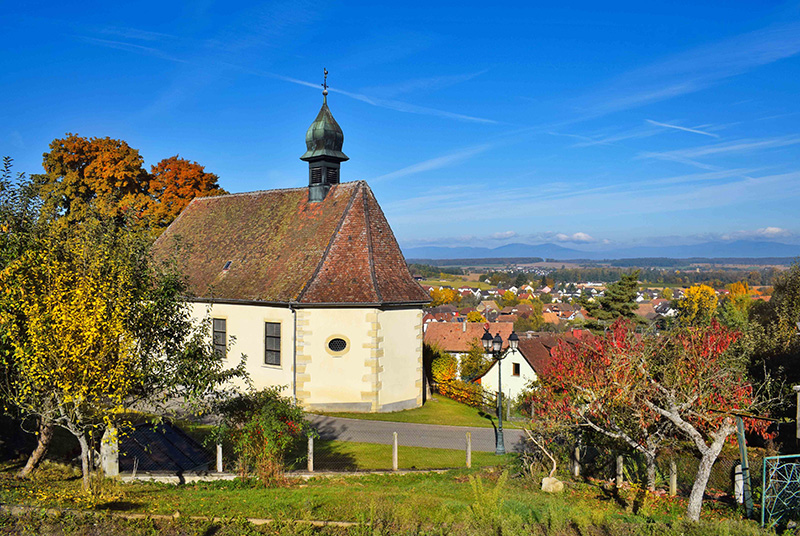
Autumn in the Sundgau (Hirtzbach) © French Moments
But the Sundgau, far from being under the spotlight, hasn't always lived in the shadows of anonymity. One must journey back to the Middle Ages to grasp the historical brilliance of this region.
As the year 2000 approached, the past of the Sundgau resurfaced, thanks to the dedicated efforts of brave local historians. These custodians of knowledge brought to light the incredible destiny of a family deeply rooted in Alsace, destined to become one of the most powerful in the world: the Habsburgs.
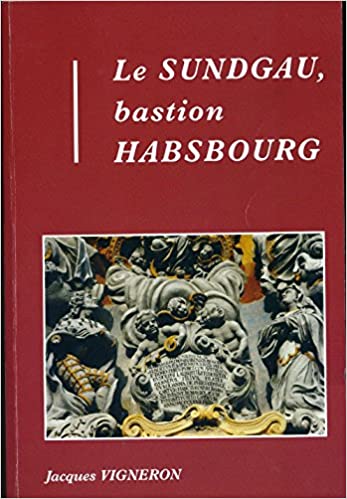
By the way, they also debunked a few misconceptions:
- Alsace wasn't a homogeneous block but rather a patchwork of autonomous territories: counties, lordships, imperial cities, abbey territories, and so on.
- At one point, Upper Alsace was under Austrian domination (not the "modern" German sense we know today).
- Belfort (now in the Bourgogne-Franche-Comté region) was in on the action, playing the role of a Gibraltar to the west for Austria.
Now, let's journey back in time together and land around the year 1000!

The Habsburgs in Alsace
But where on earth do these Habsburgs come from?
Certainly not from Austria (we'll discover later that they got their hands on it towards the end of the 13th century).
The Habsburgs themselves claimed to descend from Priam, the king of Troy, Julius Caesar, and King Arthur.
But, let's be realistic, the truth is far more modest, much to the chagrin of Marie-Antoinette's ancestors.

Obscure origins lost in the mists of time
In fact, tracing the roots of this family before the year 1000 is a bit like searching for a needle in a haystack. However, we have some solid clues suggesting that the Habsburg precursors sprouted in the Upper Rhine region, forming a triangle of lands that now belong to France, Germany, and Switzerland.
For many historians, the Habsburg lineage may have connections with the Etichonids through Guntram the Rich, Count of Alsace from 917 to 954.
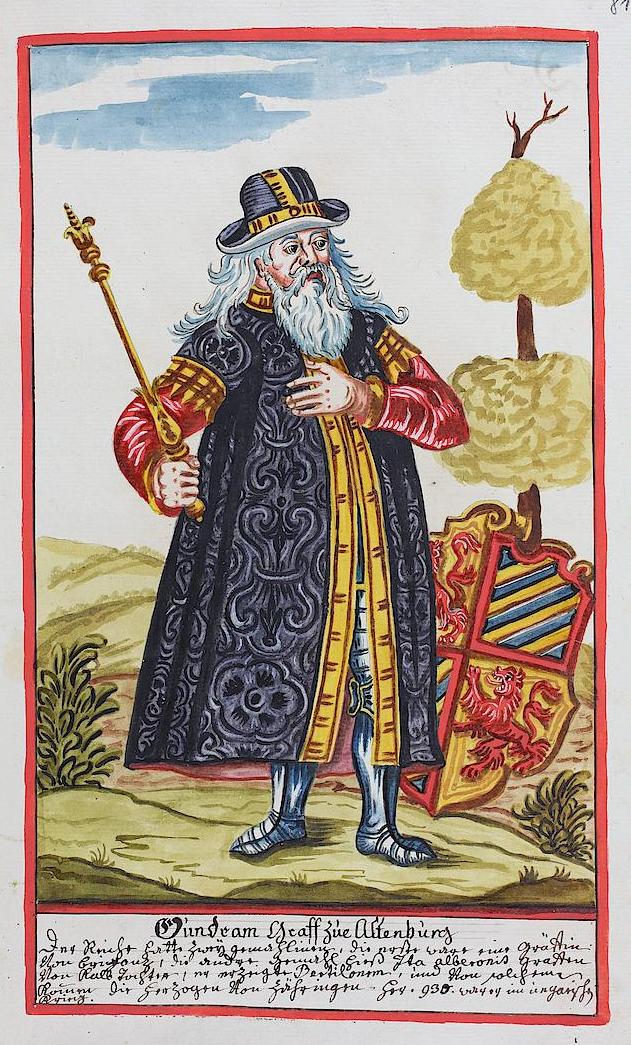
Guntram the Rich aka Gontran le Riche in French
These Etichonids were a prominent Merovingian royal family, descending from Etichon-Adalric of Alsace, who ruled over Alsace in the 7th and 8th centuries. One of the most notable figures of this tribe was Saint Odile of Hohenbourg, the protector of Alsace.
So, in essence, the Habsburgs would be... Alsatian! 🥨
A Habsburg castle in Aargau
But here's the tricky part. Around the year 1000, counts adopted the custom of taking the name of the place where they resided. This is where historians find themselves in a bit of a pickle when they attempt to delve into the etymology of the Habsburg ancestors.
So, Habsburg is actually a condensed version of Habitschburg (in French, "falcon castle" - although historians merrily bicker over the etymology). It's the affectionate nickname for the castle that Count Radbot of Habsburg built on the Wülpelsberg near Brugg in Aargau, Switzerland.
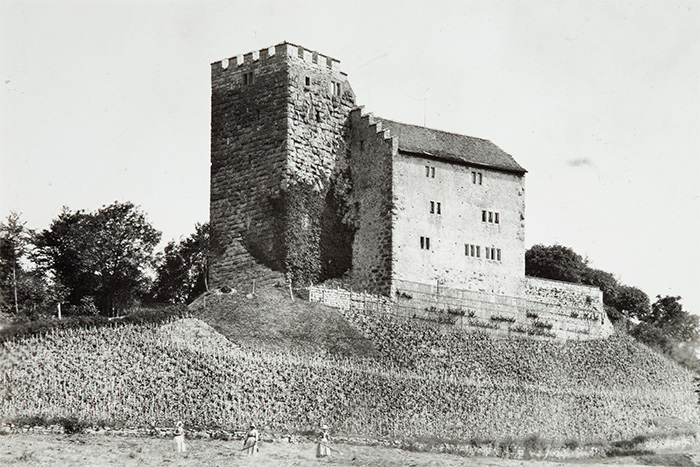
Old photo of Habsburg Castle near Brugg in Switzerland. Public Domain via Wikimedia Commons
I've passed through there countless times, driving between the Sundgau and Zurich, emerging from a highway tunnel (the Habsburg Tunnel) that cuts through the mountain. As the view unfolds, there's the castle, which, surprisingly, lacks the grandeur you might expect: the structure looks more like a robust fortified house than a majestic castle.
An ambitious family from day one!
At the beginning of the millennium, the dynasty was more in "tight budget" mode: a few lands around Ensisheim, the Hohlandsbourg Castle near Colmar, and selected pieces in Aargau, Switzerland.
From Rudolph of Altenburg, who died without an heir and was the grandson of Guntram the Rich, we remember the foundation of the Abbey of Saint Peter and Saint Paul in Ottmarsheim, Alsace. An architectural masterpiece that speaks volumes about the family's ambitions.
It's worth noting that the church is heavily inspired by the Palatine Chapel in Aachen (Charlemagne's private chapel) and the Church of the Holy Sepulchre in Jerusalem (the tomb of Christ).
A growing influence in Alsace
At the forefront of political engagement and propelled by a matrimonial strategy as cunning as a fox in a suit, the descendants of Guntram the Rich managed to lock down their control over extensive territories in Alsace, Switzerland, and the Black Forest.
Their power headquarters, primarily focused on politics with a sprinkle of land here and there, took root in Alsace. As early as the 12th century, the Habsburgs laid claim to:
- The landgraviate (provincial county) of Upper Alsace,
- The avouerie over Strasbourg episcopal lands (Haut-Mundat), and most notably,
- The avourie over the Abbey of Murbach, the rockstar of abbeys at the time.
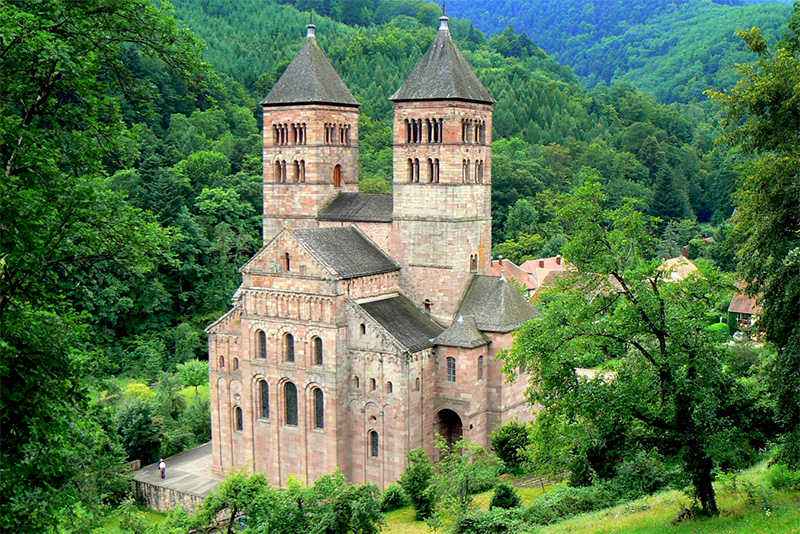
Murbach Abbey © French Moments
Unlike the Counts of Montbéliard or Ferrette, who were primarily landowners, the Habsburgs played the political game with finesse, using their influence and deploying their strength in the service of others. A strategy that paid off in the centuries to come... 👑✨
What is a landgraviate?
A landgrave was a noble title used in certain Germanic regions during the Middle Ages. The landgrave was typically a count or a high-ranking noble tasked with governing a significant territory, often referred to as a landgraviate.
Therefore, the landgraviate was the jurisdiction or territory under the rule of the landgrave. It could encompass cities, villages, farmlands, and other properties. Landgraves held administrative and military responsibilities and were often invested with the power to collect taxes and administer justice within their territory.
In the context of our story, this means that the Habsburgs gained control and sovereignty over the southern half of Alsace. As holders of the landgraviate, the Habsburgs undertook administrative, legal, and potentially fiscal responsibilities in this area, thus reinforcing their influence and territorial presence in the region.

The double-headed eagle of the Habsburgs on a keystone in the collegiate church in Thann © French Moments
What is an Avouerie?
An avouerie was a medieval institution in the Holy Roman Empire and other regions of Europe. The term "avouerie" is derived from the French word "avoué," which referred to a protector or guarantor.
Generally, an avouerie was a legal arrangement where a secular lord or noble family, known as the avoué, was entrusted with the protection and management of ecclesiastical properties, such as lands, monasteries, or abbeys. In exchange for these responsibilities, the avoué often received rights to the income generated by these properties.
In the context of our story, the avouerie over Strasbourg episcopal lands and the Abbey of Murbach indicates that the Habsburgs had taken on the role of protectors and managers of these ecclesiastical properties, thereby strengthening their power and influence.

The villages of Spechbach in the Sundgau, formerly Austrian territory © French Moments
The transformation of the Habsburgs' status occurred in 1273 when, following his election as emperor, Count Rudolph IV of Habsburg, an ally of the citizens of Strasbourg and Zurich, adopted the name Rudolph I of Habsburg.
King Rudolph: from the Rhine to the Danube
It is in the Speyer Cathedral that the tombstone of Rudolph of Habsburg is located, the figure through whom the dynasty managed to carve out a prominent place in the annals of history.
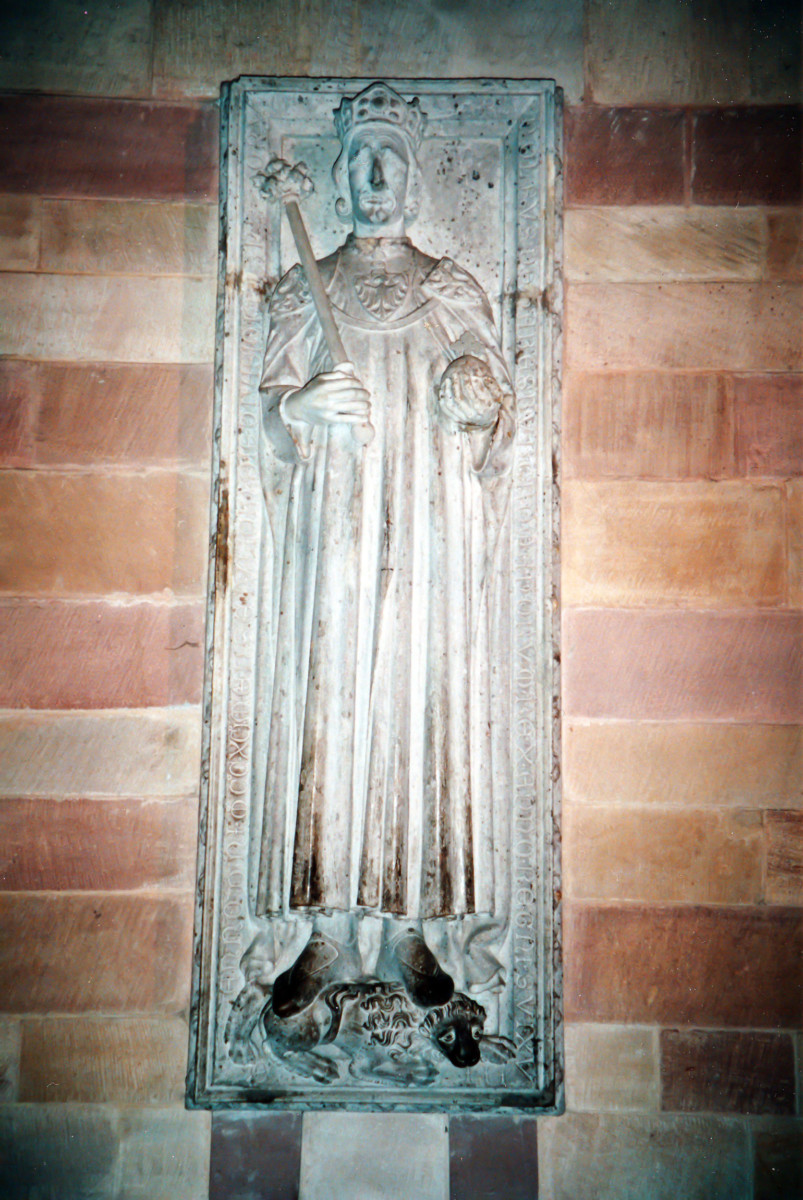
The tombstone of Rudolf of Habsburg, Speyer Cathedral © French Moments
In 1273, the German prince-electors initially regarded him as a second-rate choice for the position of King of the Romans (of the Holy Roman Germanic Empire), seeing him as a somewhat lost provincial noble.
But well, they had seriously underestimated the man. When he learned the election results, the Bishop of Basel is rumored to have uttered something along the lines of:
"Lord, God in heaven, secure your throne tightly, or this Rudolph might just snatch it from you."
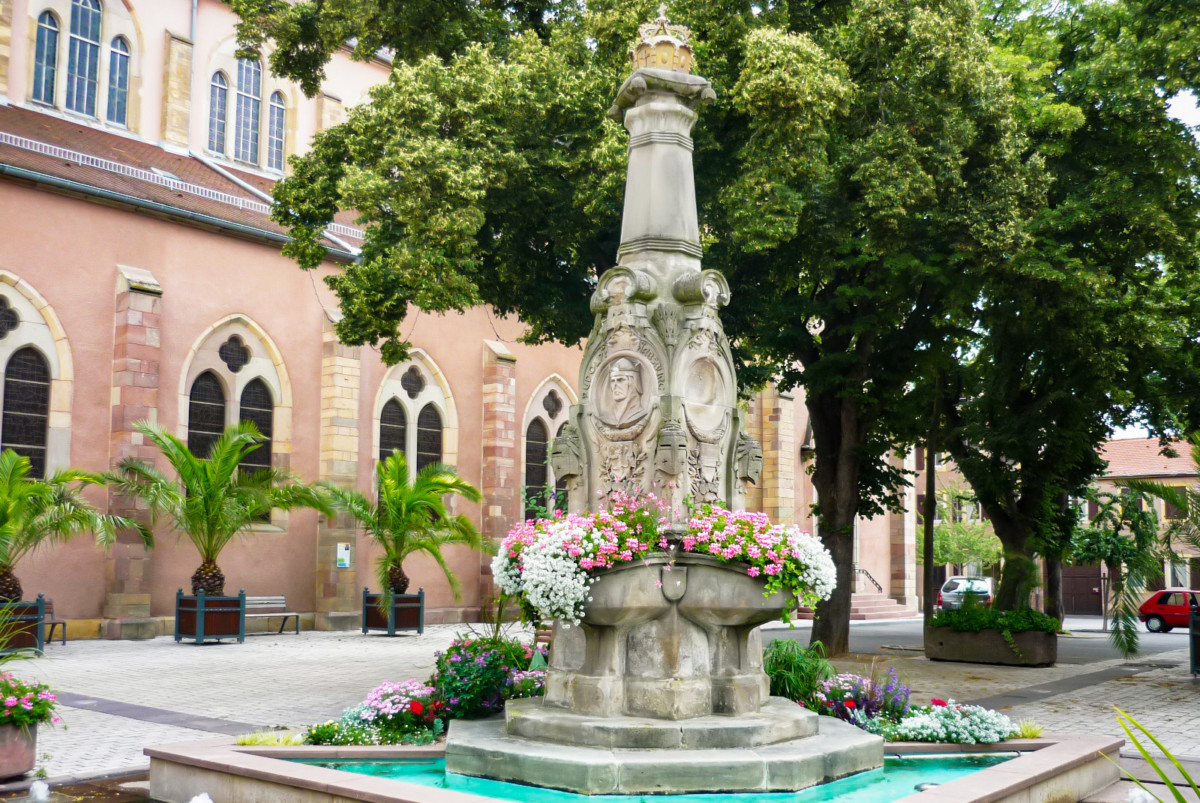
The Rodolphe de Habsbourg fountain in Ensisheim (Alsace) © French Moments
Between 1278 and 1282, Rudolph went into conquest mode and snagged the Duchies of Austria and Styria. He laid the foundations for the future Danube Empire, with the Austrian states forming the political center of power.
From then on, the Habsburg family went through its royal crisis and became a powerhouse dynasty, gradually shifting the center of gravity from the romantic Rhine shores to the banks of the majestic Blue Danube. Now, that's what you call a successful royal migration! 🏰🌊

Albert and Jeanne : a beautiful love story
Diving into the intricacies of the history of the Habsburgs in Alsace, one cannot overlook a standout event: the marriage of Albert and Jeanne.
But before unveiling the festivities, let's do a quick recap.
It's the year 1324.
As we've seen, the Habsburgs owned some patches of land in Alsace around Ensisheim, Ottmarsheim, and Landser. Their strategy? Play the influence card, notably by becoming landgraves of Upper Alsace.
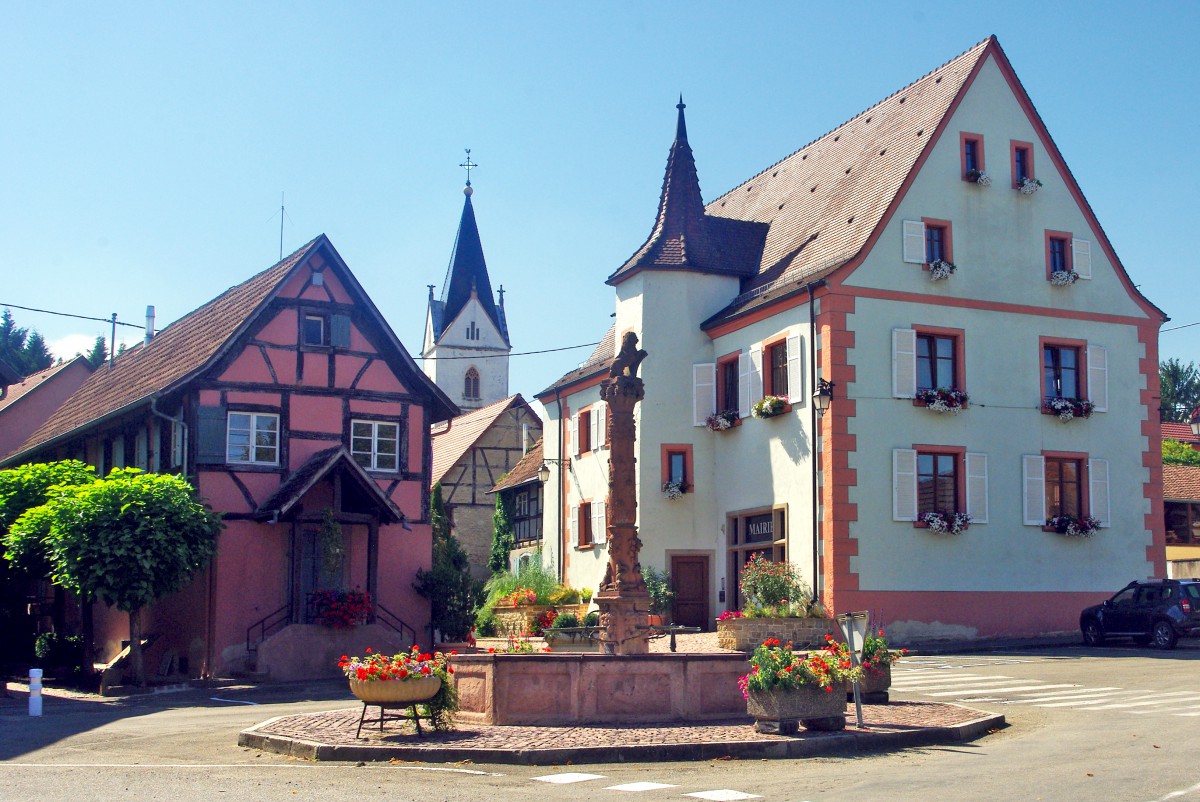
Place de la paix in Landser (Alsace) © French Moments
The predicted end of the County of Ferrette
The lion's share of the High Alsace cake belonged to another team: the Counts of Ferrette. They ruled supreme over the current Sundgau: Altkirch, Ferrette, and even Thann.
I've delved into this captivating saga in a previous article (in French here), so I'll spare you the details.
Ulrich III, the Count of Ferrette, found himself in a delicate position. Ailing and realising that no male heir would come forth, he took measures to protect his county from the appetites of the Bishop of Basel.
However, Ulrich had two charming daughters, with the eldest going by the sweet name of Jeanne. The count and his wife, Jeanne de Montbéliard, shrewdly negotiated with the pope to allow their properties to follow the female line and land in the hands of their dear Jeannette. On Dad's side, Jeanne would inherit the County of Ferrette, and on Mom's side, she would acquire Belfort.
On February 8, 1320, the good news from Avignon rained down like confetti: Pope John XXII granted them the right of succession for their little girl.
Ulrich asked the Landgrave of Upper Alsace (a Habsburg) to act as a bodyguard for Jeanne and oversee the proper execution of the papal agreement. Then, the last Count of Ferrette breathed his last on March 15, 1324, in Basel, unaware of the extraordinary destiny awaiting his lineage.
The Habsburgs under existential threat?
On the Habsburg side, things weren't looking too cheerful. Duke Albert I (assassinated in 1308) had five sons: Rudolf, Leopold, Frederick, Albert, and Otto.
The Swiss, in rebellion mode, weren't making life easy for them. The monumental defeat of the Habsburgs at the Battle of Morgarten on November 13, 1315, shook up Duke Frederick's affairs. Without a male heir, he resigned dramatically. His elder brother Rudolf hung up his boots prematurely, leaving the offspring disappointed. As for the youngest, Leopold, he took on the roles of Duke of Austria and Styria in 1308, only to fade away in 1326 in Strasbourg, still without a male successor.
Who will stand in the gap?
Oh, the sad fate of the descendants of Albert I! Of the five cheerful kids, only Albert, destined for an ecclesiastical career, and the youngest, Otto, remained. Unfortunately, Otto bid farewell at the tender age of 38 in 1339, and to top it off, his two sons exited the stage prematurely (possibly poisoned?) in 1344, even before reaching the age of majority.
Here's Charlemagne putting in his two cents
As if things weren't twisted enough, the Prince-Electors added another layer of drama: from now on, anyone aspiring to the imperial throne had to prove a lineage tracing back to Charlemagne. A considerable challenge for the Habsburgs, who seemed incapable of meeting this requirement (remember, they were just simple Alsatian nobles!)
The survival of the House of Austria was clearly under the shadow of an existential threat...
The marriage that saved the day
Fortunately for them, Albert, known as "the Wise," saved the lineage from extinction through his marriage to... Jeanne de Ferrette.

Seraient-ce Albert II et Jeanne de Ferrette dans ce vitrail du 19e siècle de la Collégiale de Thann ? © French Moments
At the death of the last Count of Ferrette, there was no time to waste. A marriage contract was drawn up and signed on March 17, 1324, in Thann, and the agreement was blessed by the Bishop of Basel in Masevaux on March 26.
As for the celebration, it took place in May 1324, somewhere. Opinions differ on the location: in front of the nobility of Basel or that of Vienna.
The two fish from the Ferrette coat of arms were integrated into the Austrian flag, the three red-white-red stripes.

The coat of arms of the Habsburgs and the Counts of Ferrette (Ferrette town hall) © French Moments
The County of Ferrette was saved, and Jeanne brought to her new husband:
- The title of Count of Ferrette, allowing the Habsburgs to expand their holdings despite the loss of territory to the Swiss. Altkirch, Belfort, Ferrette, and Thann entered the Austrian sphere.
- The perfect solution to the new constraint imposed by the Prince-Electors (remember, to vie for the imperial crown, one had to be of the lineage of Charlemagne—and the Habsburgs took advantage of this a century later).
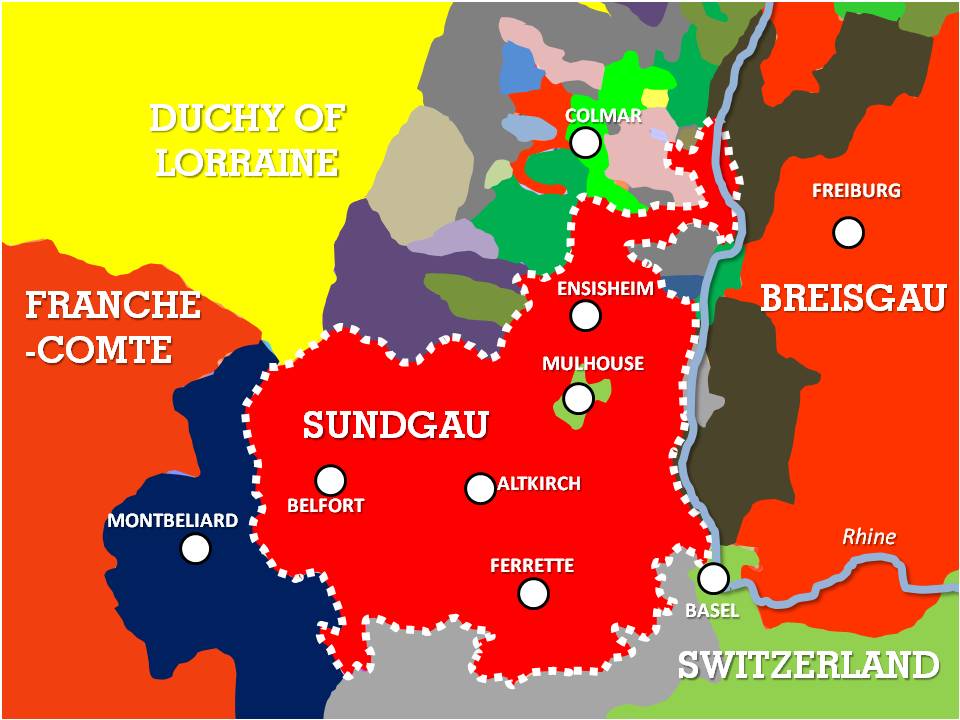
In red: the possessions of the Habsburgs in Alsace © French Moments
The stork takes its time...
However, fate seemed to have its challenges for the couple. For years, the stork played hide-and-seek with Albert and Jeanne. While her younger brother, Otto, had already hit the jackpot with two little boys born in 1327 and 1328 (who wouldn't survive beyond 1344).
But in 1339, after 15 years of marriage (and a pilgrimage to Aachen and Cologne), Jeanne de Ferrette finally joined the moms' club with the birth of her first son, Rudolf IV. Phew, the dynasty and its rich heritage were safe!
![Johanna_von_Pfirt Vitrail de Abbaye de Saint-Florian (Autriche) représentant Jeanne de Ferrette [Domaine public]](https://frenchmoments.eu/wp-content/uploads/2023/12/Johanna_von_Pfirt.jpg)
Stained glass window from Saint-Florian Abbey (Austria) depicting Jeanne de Ferrette [Domaine public via Wikimedia Commons]
Then, she gave birth to five more children, the youngest, Leopold III, making his appearance on November 1, 1351. But this birth was marked by tragedy. At the age of 51, Jeanne de Ferrette fell ill and bid her farewell on December 17, 1351. She was laid to rest in the Church of the Gaming Charterhouse in Lower Austria, founded by her husband in 1330.
Jeanne de Ferrette: Europe's grandmother
If you remember your history lessons at school, you were taught that Queen Victoria was nicknamed the grandmother of Europe.
This nickname also fits extremely well with Jeanne de Ferrette. Just think, from her offspring emerged German emperors, Spanish kings, Dutch dukes, Italian monarchs, French sovereigns, Austro-Hungarian emperors, and even the offspring of Napoleon I (the Eaglet). Not bad for a little Countess from Alsace, right?
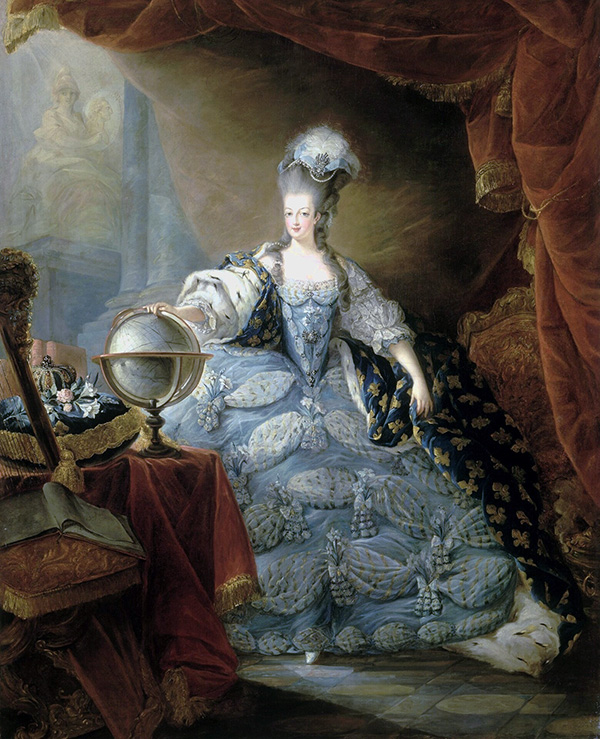
Marie-Antoinette of Austria circa 1775, a distant descendant of Jeanne de Ferrette
The Habsburg marriage agency
The Habsburgs had a strategy all their own: rather than brandishing the sword recklessly, they preferred to play the matchmakers. Matthias Corvinus, King of Hungary, understood them well when he said:
The powerful make war,
You, happy Austria, make marriages.
What others hold by the sword,
You obtain with love!
Well, between you and me, they also knew how to handle a sword when they needed to. This was a medieval world, not a Hollywood romantic comedy, after all!

Anterior Austria and the Habsburgs in Alsace
And that's how the couple Albert II and Jeanne de Ferrette waved their magic wand (or rather scepter) over Vienna!
In 1330, they settled in the Austrian capital and established an administration that was quite modern for the time. Albert clearly spruced up Vienna's resume.
![Jeanne de Ferrette © vlastní fotka - licence [CC BY 3.0] from Wikimedia Commons Jeanne de Ferrette © vlastní fotka - licence [CC BY 3.0] from Wikimedia Commons](https://frenchmoments.eu/wp-content/uploads/2023/12/Jeanne-de-Ferrette-©-vlastni-fotka-licence-CC-BY-3.0-from-Wikimedia-Commons.jpg)
Statue of Jeanne de Ferrette in the Wien cathedral © vlastní fotka - licence [CC BY 3.0] from Wikimedia Commons
A cake cut into three slices
The job wasn't finished after them. The Treaty of Vienna in 1396 sliced Austria into three pieces, a bit like a cream-filled cake:
- Inner Austria: with Upper Austria and Lower Austria to savour.
- Styria, Carinthia, Trieste, and Istria: for those who like a bit more spice and adventure.
- Anterior Austria (Vorderösterreich): an assortment of Habsburg regions west of Tyrol, in Alsace, in the Breisgau and Black Forest, in Swabia, and Vorarlberg. If these names don't ring a bell, perhaps cities like Altkirch, Belfort, Bregenz, Breisach, Constance, Freiburg im Breisgau, Thann... sound familiar.

The Sundgau, a Habsburg stronghold
The Sundgau became a sort of Habsburg headquarters in Austria. A strategic point from which the dynasty planned the conquest of Europe... and the world. Let's not forget the famous motto AIEOU of Emperor Frederick III:
"Austriae Est Imperari Orbi Universo"
Which roughly translates to something like: "It is given to Austria to rule over the whole world."
It's crazy to think that nowadays, Austria is rather a small, tranquil country of 9 million people without access to the sea.
But let's go back to France... uh, sorry, to Anterior Austria, with its capital in Ensisheim. If you're not familiar, it's worth a little detour between Mulhouse and Colmar.

Palais de la Régence, Ensisheim © French Moments
And guess what? The city's coat of arms still bears the colors of the Austrian flag! It's as if Ensisheim has kept a little Austrian flame burning.
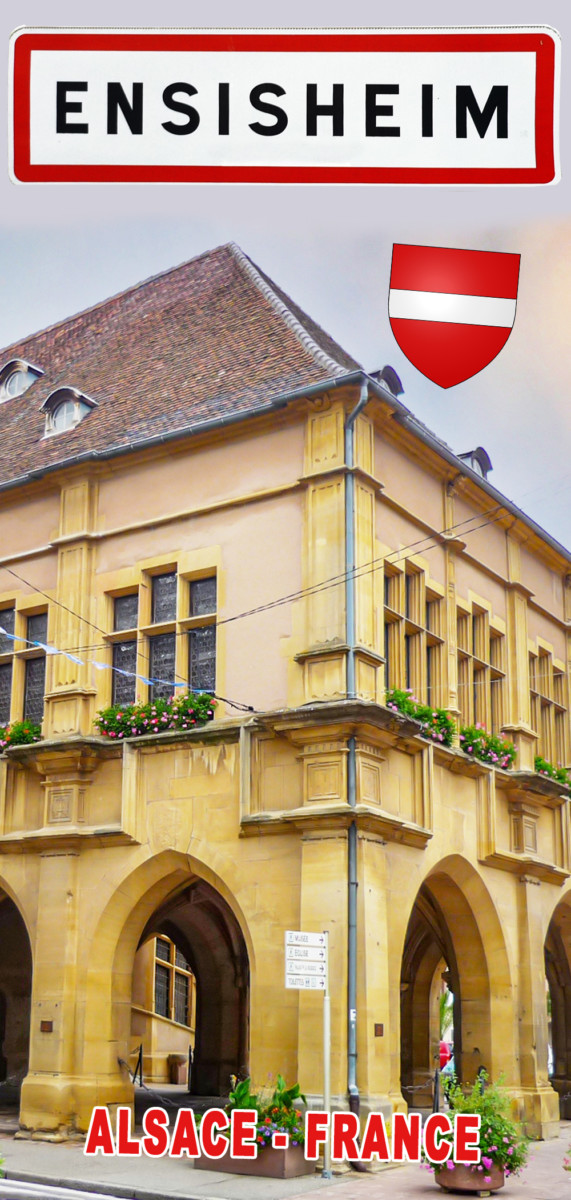
Moreover, Ensisheim is not the only municipality in the French Republic to display the colors of Austria. Three other municipalities in the Haut-Rhin département have kept the red-white-red flag on their coat of arms: Battenheim, Dessenheim, and Thann.

The coat of arms of Thann on a keystone in the collegiate church © French Moments
The end of Austrian domination in Alsace
Ah, the Thirty Years' War, that turbulent period from 1618 to 1648 that shook the political map of Europe and Anterior Austria as strongly as an earthquake in the Alps!
The Treaties of Westphalia reshuffle the deck
The Treaty of Münster (one of the two Peace of Westphalia treaties along with the Treaty of Osnabrück) decided that the Habsburgs had to bid farewell to their hereditary lands in Alsace, offering them to Louis XIV, the Sun King. On October 24, 1648, the Austrian border was pushed to the right bank of the Rhine.
Ensisheim, which had been the capital of Anterior Austria for some time, had already passed the torch to Breisach in 1632. Then, it was Freiburg im Breisgau's turn to become the seat of the Vorderösterreich from 1651 onwards.
Thus, between 1648 and 1805, France found itself a neighbour to Austria. And guess who put a definitive end to what remained of Anterior Austria? Well, none other than Napoleon Bonaparte, of course!
Napoleon and the end of Anterior Austria
It was Bonaparte who orchestrated the end of this story through the Treaty of Pressburg in 1805. Napoleon, the master of rewards, distributed the slices of the cake:
- The Ortenau and Breisgau went to the Grand Duchy of Baden,
- The Fricktal joined the Swiss canton of Aargau,
- While Württemberg laid claim to Konstanz and Habsburg lands scattered in Swabia.
Except for the Vorarlberg, the Habsburgs thus lost all their territories to France, Switzerland, and the precursor states of the German Empire.
And to conclude this chapter of history, the prestigious Rue de Presbourg in Paris, forming half of the arc around the Place de l'Étoile, is there to subtly remind us, like an Austrian waltz, of the treaty that bid farewell to Anterior Austria.
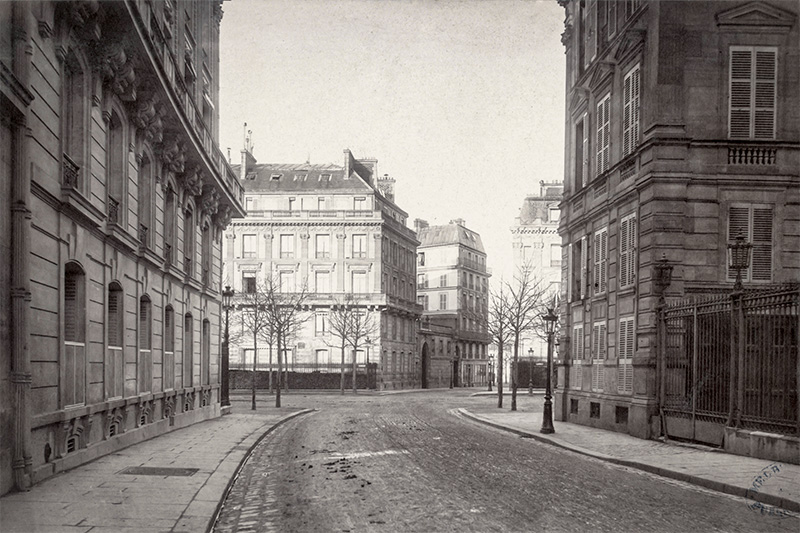
Rue de Presbourg photographed by Charles Marville between 1864 and 1870. Photo Public Domain via Wikimedia Commons

The great anniversaries of the Habsburgs in Alsace
At the beginning, it was an "anniversary" that sparked my interest in these lesser-known episodes of our regional history. Flashback to 1996.
996-1996 - the millenium of Austria
In 1996, Austria celebrated its millennium. Indeed, it was in 996 that the first appearance of the name Ostarrichi (the Eastern territories) was recorded in a deed of donation by Emperor Otto III. Ostarrichi would later evolve into Österreich in German, Austria in English and Autriche in French.
Therefore, in 1996, this millennium was celebrated not only in Austria itself but also in the territories that had constituted the Habsburg's former Vorarlberg region.
![Laufenburg © JoachimKohler-HB - licence [CC BY-SA 4.0] from Wikimedia Commons Laufenburg © JoachimKohler-HB - licence [CC BY-SA 4.0] from Wikimedia Commons](https://frenchmoments.eu/wp-content/uploads/2023/12/Laufenburg-©-JoachimKohler-HB-licence-CC-BY-SA-4.0-from-Wikimedia-Commons.jpg)
Laufenburg (Germany) on the Rhine, a former Vorderösterreich town © JoachimKohler-HB - licence [CC BY-SA 4.0] from Wikimedia Commons
A cross-border initiative in honour of Austria
For the celebration of Austria's Millennium, Alsace, Baden, Northwestern Switzerland, and Austrian Vorarlberg seized a major opportunity to promote cross-border cultural tourism while highlighting their shared heritage.
Tourist agencies made significant efforts, publishing promotional materials in both French and German to comprehensively present thematic circuits, from Tyrol to Alsace. I have a tangible testimony of this initiative: a copy of a brochure titled "Voyages sur les traces des Habsbourg" (Journeys in the Footsteps of the Habsburgs), printed in 136,000 copies.
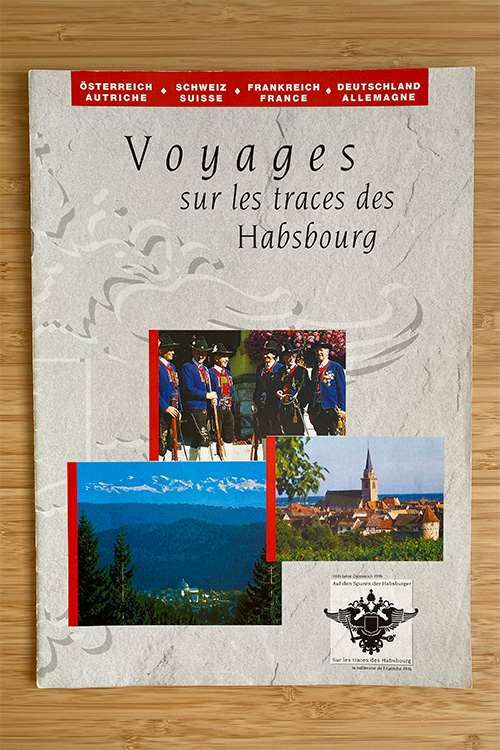
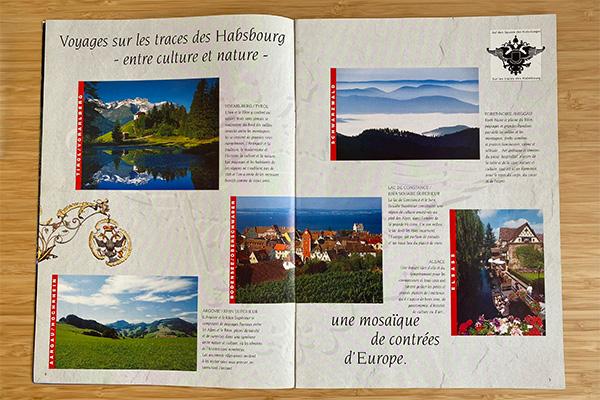
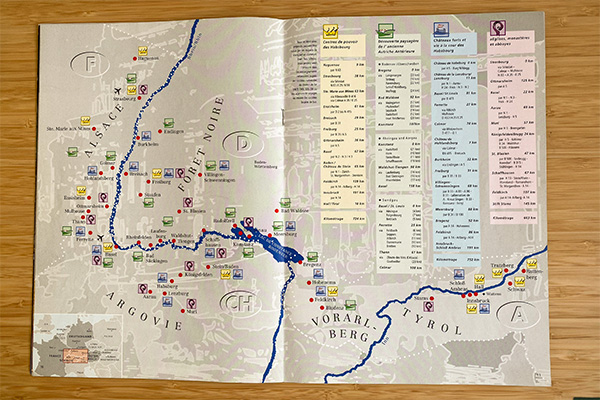
The results were successful, with a notable 14% increase in the number of Austrian tourists visiting the former Anterior Austria regions during the 1996-97 period. This highlighted the positive impact of promoting cross-border cultural tourism and emphasising the shared heritage of these regions.
1648-1998 - 350 years since the Treaties of Westphalia
Two years later, another significant event occurred—the 350th anniversary of the Peace of Westphalia, signed in Osnabrück and Münster. Of particular interest is the treaty signed in Münster on October 24, 1648.
The Peace of Westphalia played a crucial role in redefining the borders of several European nations, including the Habsburg territories. In this context, the Alsace territories, traditionally belonging to the Habsburgs, were confiscated and given to the Kingdom of France.
This marked a historic moment as it was the first time the Sundgau region became part of France. To commemorate this event, numerous activities, conferences, and exhibitions were organised in Upper Alsace, including Belfort, which, as a reminder, was an Alsatian city until 1871.
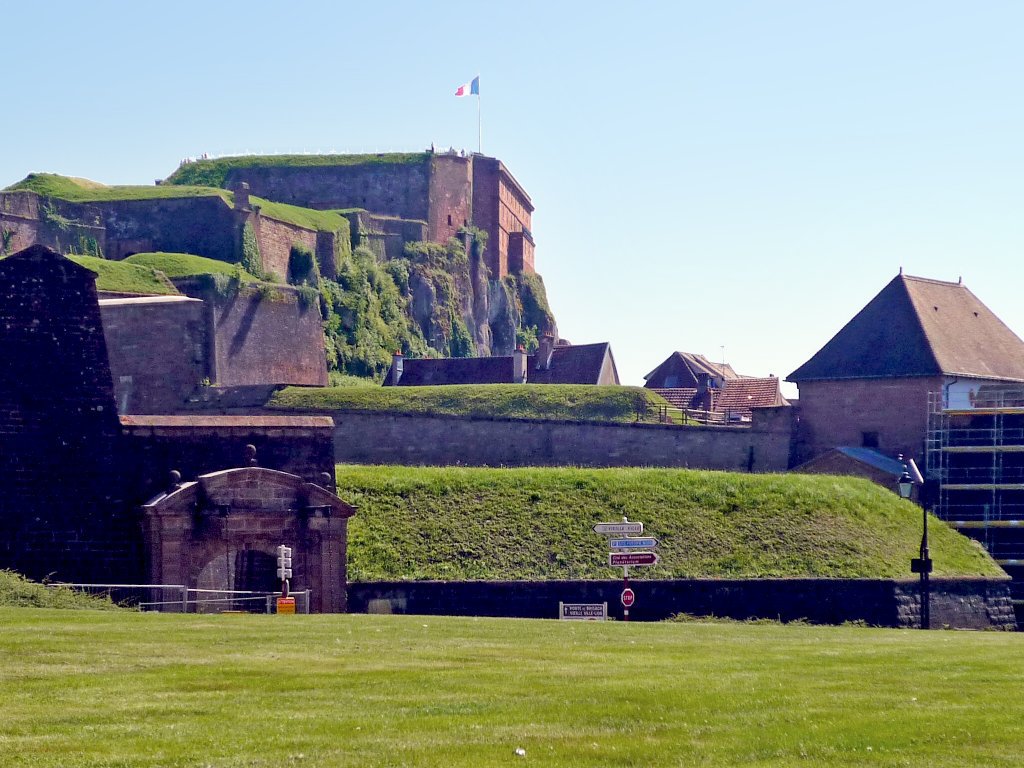
The citadel overlooking the fortifications of Belfort © French Moments
1324-2024 - 700 years since the wedding that changed everything
The next significant event is set to take place in 2024 to commemorate the 700th anniversary of the marriage between Albert II of Habsburg and Jeanne de Ferrette.
Currently, conferences and exhibitions are being organized in Upper Alsace to promote this crucial date in regional history.

The final word on the Habsburgs in Alsace
As we conclude this fascinating exploration of the traces of the Habsburgs in Alsace, we have unveiled an overlooked history, a legacy inscribed in stones and forgotten tales. Upper Alsace, this exotic corner of former Austria, often relegated to obscurity, has come to life before our eyes.
From alliances worthy of a medieval soap opera to castles that have witnessed more drama than the best episodes of Netflix series, we have journeyed through time together. From a salvational marriage 700 years ago to the Treaties of Westphalia, this blockbuster tells a saga often omitted in history textbooks.
Throughout our voyage into this lesser-known chronicle, we discovered the influence of the Habsburgs, their strategic alliances, and the crucial role of Upper Alsace in the geopolitical upheavals of the time. The Treaties of Westphalia, the final act of the Thirty Years' War, sealed the fate of this region, propelling it into the pages of French history.

Altkirch, the current capital of the Sundgau region © French Moments
As we close this chapter, let's remember that history is like a box of chocolates; you never know what you're going to get. These forgotten stories are like rare pearls, and Upper Alsace finally regains its moment of glory in the grand theater of European history.
So, may this journey into the buried treasures of the Habsburgs in Alsace be an invitation to explore further. Open your eyes wide to the forgotten tales, and may every street corner be like a little flashback to the past. Thank you for joining me on this historical adventure! May your future explorations be as captivating as the intrigues of the Habsburgs in Alsace. 🚀📜✨
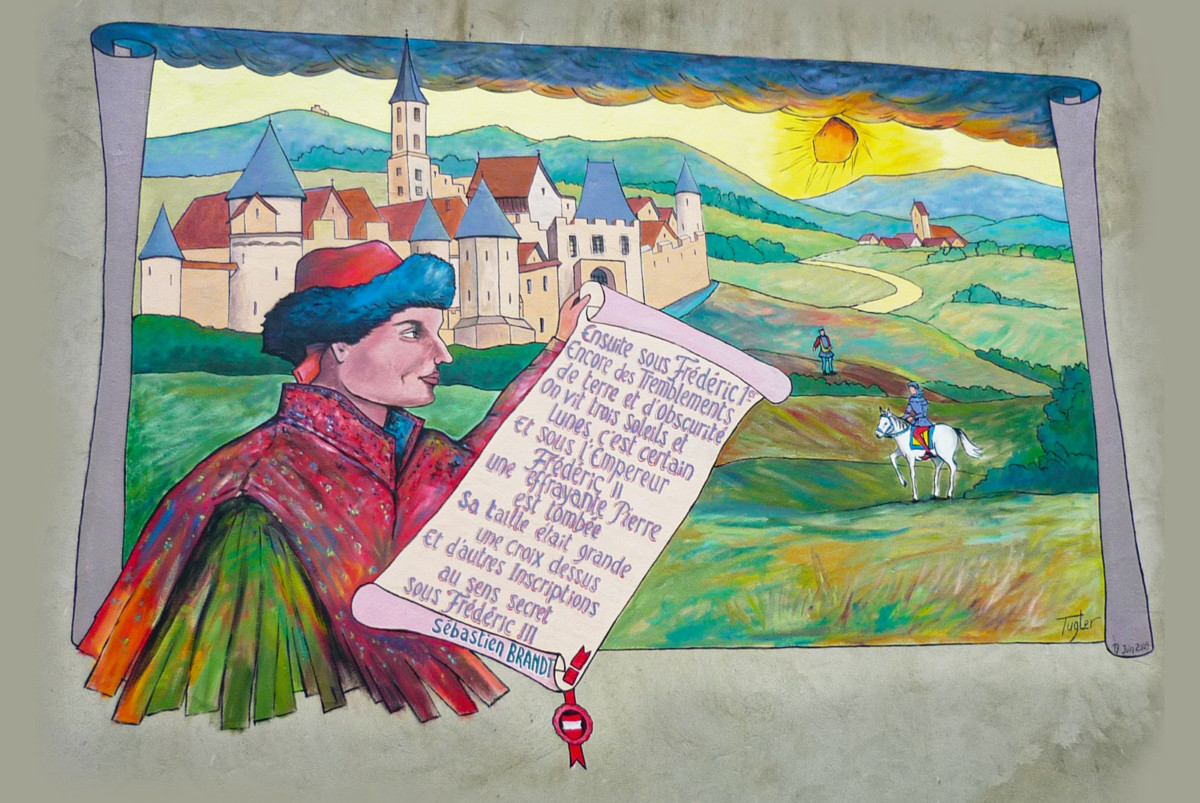
Fresco depicting Sébastien Brandt and the Ensisheim meteorite © French Moments

The Habsburgs in Alsace: learn more
This article is not the first on the subject to be published on the blog. If you're interested in finding out more, click on one of the following links which will take you to another blog post:
On our French blog Mon Grand-Est:
- Read this article in French!
- L'histoire passionnante du comté de Ferrette
- Ensisheim, la capitale de l'Autriche antérieure
- Sur les traces des Habsbourg à Thann
- L'incroyable histoire du Sundgau autrichien
- La météorite d'Ensisheim : un signe divin pour les Habsbourg ?
And elsewhere on the web :
- The Wikipedia page on Anterior Austria
- The website of Via Habsburg, a cultural route of the Council of Europe
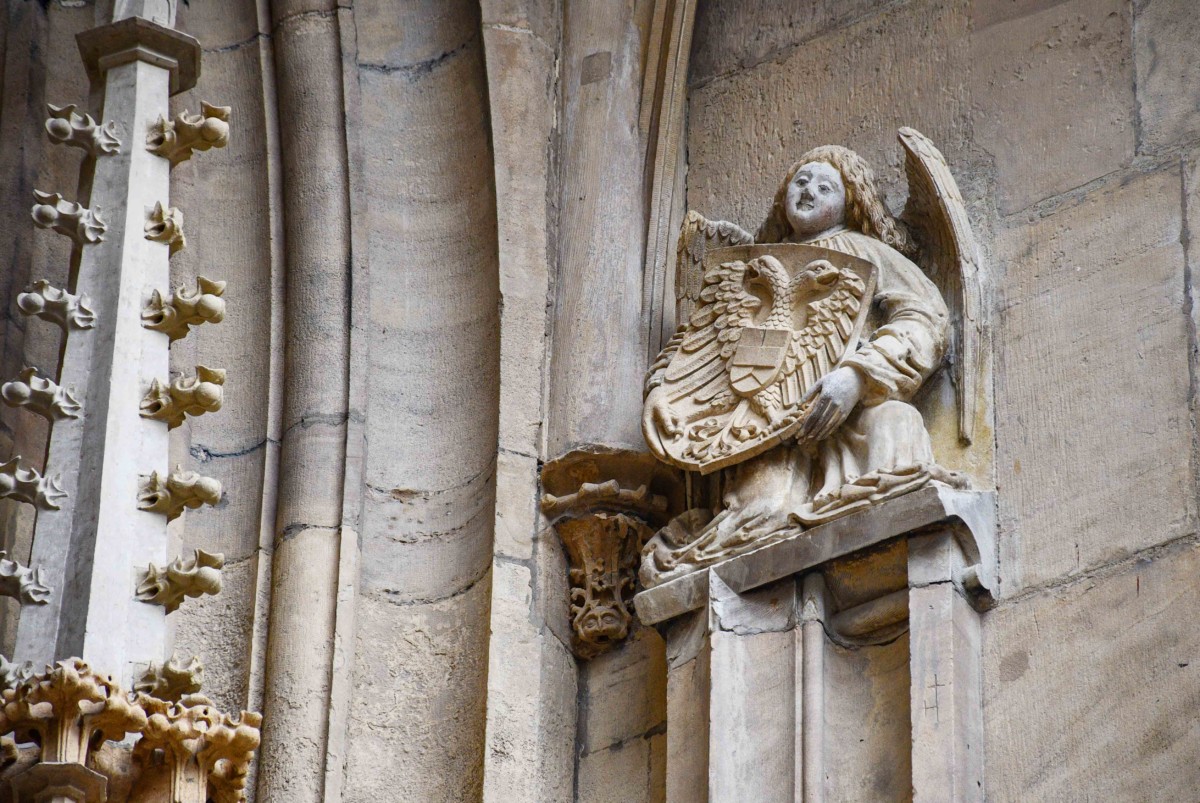
The Habsburg coat of arms on the western portal of the Collegiate Church of Thann © French Moments


![Habsburg Schloss © Roland Zumbuehl - licence [CC BY-SA 3.0] from Wikimedia Commons Habsburg Schloss © Roland Zumbuehl - licence [CC BY-SA 3.0] from Wikimedia Commons](https://frenchmoments.eu/wp-content/uploads/2023/12/Habsburg-Schloss-©-Roland-Zumbuehl-licence-CC-BY-SA-3.0-from-Wikimedia-Commons.jpg)
![Ottmarsheim Place de l'Abbatiale © Espirat - licence [CC BY-SA 4.0] from Wikimedia Commons Place de l'Abbatiale © Espirat - licence [CC BY-SA 4.0] from Wikimedia Commons](https://frenchmoments.eu/wp-content/uploads/2023/12/Ottmarsheim-Place-de-lAbbatiale-©-Espirat-licence-CC-BY-SA-4.0-from-Wikimedia-Commons.jpg)
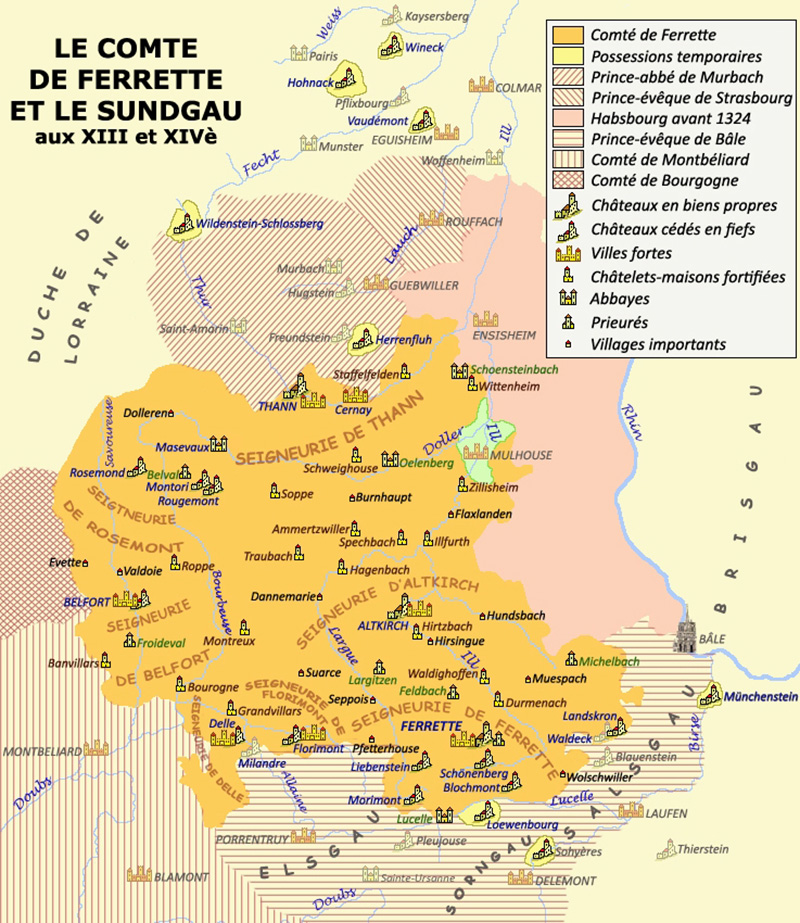
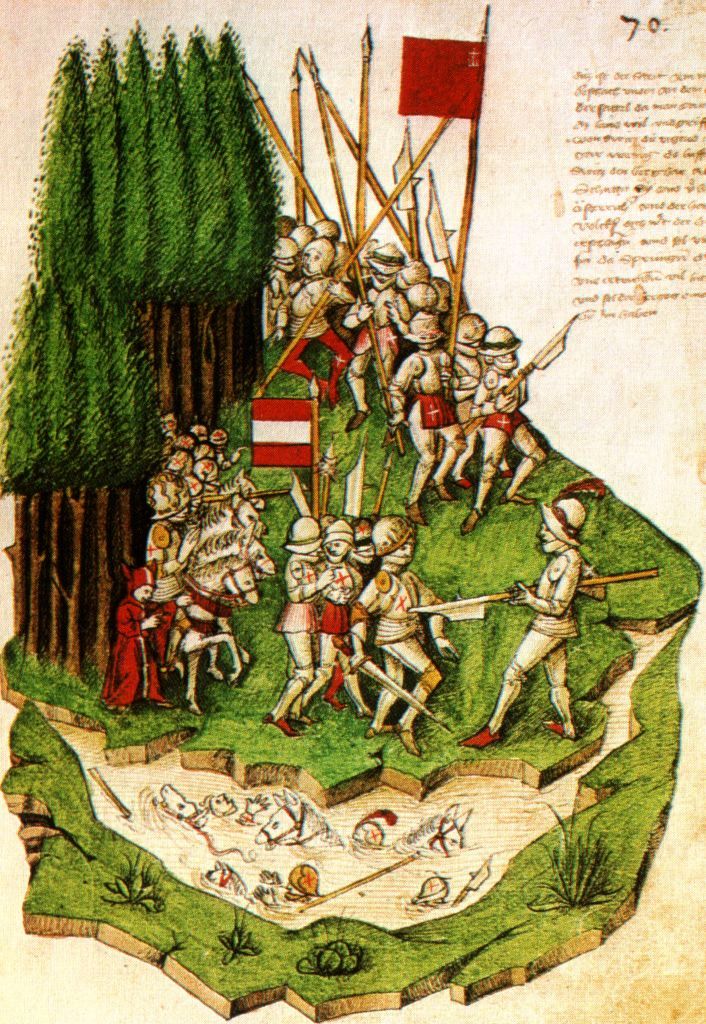
![Fribourg-en-Brisgau Cathedrale © H. Helmlechner - licence [CC BY-SA 4.0] from Wikimedia Commons Fribourg-en-Brisgau Cathedrale © H. Helmlechner - licence [CC BY-SA 4.0] from Wikimedia Commons](https://frenchmoments.eu/wp-content/uploads/2023/12/Fribourg-en-Brisgau-Cathedrale-©-H.-Helmlechner-licence-CC-BY-SA-4.0-from-Wikimedia-Commons.jpg)

